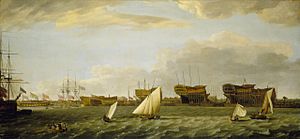HMS Plymouth (1653) facts for kids
 |
|
Quick facts for kids History |
|
|---|---|
| Name | HMS Plymouth |
| Namesake | Plymouth |
| Builder | Taylor, Wapping |
| Launched | 1653 |
| Honours and awards |
|
| Fate | Foundered, 1705 |
| General characteristics as built | |
| Class and type | Speaker-class frigate |
| Tons burthen | 74149⁄94 (bm) |
| Length | 116 ft (35.4 m) (keel) |
| Beam | 34 ft 8 in (10.6 m) |
| Depth of hold | 14 ft 6 in (4.4 m) |
| Propulsion | Sails |
| Sail plan | Full-rigged ship |
| Armament | 52 guns (at launch); 60 guns (1677) |
| General characteristics after 1705 rebuild | |
| Class and type | 60-gun fourth-rate ship of the line |
| Tons burthen | 83331⁄94 bm |
| Length | 140 ft 5 in (42.8 m) (gundeck) |
| Beam | 38 ft 3 in (11.7 m) |
| Depth of hold | 15 ft 7 in (4.7 m) |
| Propulsion | Sails |
| Sail plan | Full-rigged ship |
| Armament | 60 guns of various weights of shot |
HMS Plymouth was a powerful warship built for the navy of England in 1653. It was first known as a 52-gun frigate, which was a type of fast and strong warship. Over time, its firepower grew, and by 1677, it carried 60 guns.
In 1705, the ship was rebuilt and became an even larger and more powerful ship of the line with 60 guns. Sadly, HMS Plymouth sank later that same year.
Contents
What Was HMS Plymouth?
HMS Plymouth was a ship built for the English navy during a time when England was called the Commonwealth of England. It was designed to be a strong fighting ship. When it was first launched, it had 52 guns, making it a "third-rate" ship. This meant it was a very important and powerful warship for its time.
Building a Warship
The ship was built in a place called Wapping, which is in London. It was launched in 1653, meaning it was ready to sail that year. As years passed, the navy often upgraded its ships. HMS Plymouth was no different, and by 1677, it had more guns, increasing its total to 60.
A Big Rebuild
Ships in those days were sometimes rebuilt to make them stronger or to update their design. In 1705, HMS Plymouth went through a major rebuild at Blackwall Yard. After this, it was considered a "fourth-rate" ship of the line. This new design made it even bigger and more powerful, ready for the biggest naval battles.
Battles and Adventures
HMS Plymouth was involved in many important naval battles throughout its service. It was a busy ship, taking part in conflicts that shaped English history. Some of the battles it fought in include:
- The Action of 14 April 1655
- The Battle of Santa Cruz de Tenerife
- The Battle of Lowestoft
- The Four Days Battle
- The St James Day Battle
- The Battle of Solebay
- The Battle of Texel
- The Battle of Bantry Bay
- The Battle of Beachy Head
- The Battle of Barfleur
These battles show how important HMS Plymouth was to the English navy for many years.
The End of HMS Plymouth
After its big rebuild in 1705, HMS Plymouth did not last long. It foundered later that same year. When a ship founders, it means it sinks, usually because of damage or bad weather, and is completely lost. This was the end of a long and active career for this historic warship.

